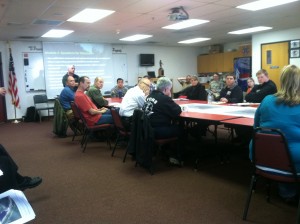A Real Partnership to Protect an Oregon Gem, the North Santiam River
Article written By Dan Heister, Emergency Response On-Scene Coordinator – EPA Region 10
The North Santiam River in Oregon’s Willamette Valley is not only beautiful to behold, but is a vital drinking water source to six Oregon cities, including Salem, the state capital. The water runs cold and clear and is home to healthy spring and summer steelhead fish runs. Unfortunately, in the last ten years it has had two petroleum tanker truck spills that directly impacted its water quality. At the request of the City of Salem, EPA Region 10 has been working with its Federal, State and local partners to develop strategies to prevent, and if necessary, respond to these types of emergencies.
To that end, Region 10 funded and participated in a North Santiam tabletop exercise (TTX) in Stayton, OR on March 19, 2015. Approximately 50 people were in attendance including representatives from the Army Corps of Engineers, OR Dept. of Environmental Quality, OR Dept. of Fish and Wildlife, OR Emergency Management, OR Fire Marshall, Marion County, Linn County, Metro 911, City of Salem and the five other municipalities that draw drinking water from the river. The private sector (cannery and agriculture), the watershed council, drinking water utilities, irrigation utilities, and the local hospital were also represented.
The Emergency Managers of Marion County and the City of Salem facilitated the TTX, which involved a mock 10,000-gallon spill of unleaded gasoline into the upper reaches of the North Santiam. Unlike most TTXs, which begin with everyone around the table, this one began with an empty table. As if it were a real scenario, the 911 operator came to the table first, followed by the Chief of the Gates Volunteer Fire Department, which is from the city closest to the incident. As notifications continued to go out, more players engaged at the table. By the end of the exercise there were about 20 folks at the table. The exercise lasted the entire day and was very well received. Among the most important lessons learned, the group recognized the need to improve their formal notification process as well as the benefits of developing a Geographic Response Plan for the N. Santiam Watershed. All participants requested a copy of the EPA’s After Action Report in order to build on the lessons from the TTX. Region 10’s Emergency Response Unit has been part of this group since 2010 and plans to remain engaged as they work to protect the North Santiam Watershed.


